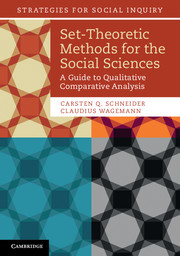Book contents
- Frontmatter
- Contents
- Figures
- Tables
- Acknowledgements
- Introduction
- Part I Set-theoretic methods: the basics
- Part II Neat formal logic meets noisy social science data
- 5 Parameters of fit
- 6 Limited diversity and logical remainders
- 7 The Truth Table Algorithm
- Part III Potential pitfalls and suggestions for solutions
- Part IV Variants of QCA as a technique meet QCA as an approach
- Glossary
- Bibliography
- Index
7 - The Truth Table Algorithm
Published online by Cambridge University Press: 05 November 2012
- Frontmatter
- Contents
- Figures
- Tables
- Acknowledgements
- Introduction
- Part I Set-theoretic methods: the basics
- Part II Neat formal logic meets noisy social science data
- 5 Parameters of fit
- 6 Limited diversity and logical remainders
- 7 The Truth Table Algorithm
- Part III Potential pitfalls and suggestions for solutions
- Part IV Variants of QCA as a technique meet QCA as an approach
- Glossary
- Bibliography
- Index
Summary
From the data matrix to truth table
In order to illustrate the Truth Table Algorithm, we use Pennings’ data ( 2003). His is a fuzzy-set QCA, but the same principles and practices apply to crisp-set QCA. Pennings is interested in the conditions for high constitutional control of the executive in parliamentary democracies (K). He identifies the presence of a consensus democracy (C), a strong presidentialist component in the political system (P), whether the democracy is new (N), and the rigidity of the constitution (R) as potential conditions. The data matrix in Table 7.1 displays each case’s fuzzy-set membership in all conditions and the outcome.
We first have to convert this data matrix into a truth table. As laid out in section 4.2, this requires three steps: the identification of all logically possible configurations; the assignment of each case to one of these truth table rows; and the definition of the outcome values for each row. Step 1 is easy and straightforward: 4 conditions produce a truth table with 16 rows.
In step 2, each case is assigned to that row in which its membership exceeds 0.5. For example, let us consider Australia. Its membership in C, P, N, and R is 0.33, 0, 0.33, and 0.83, respectively. Australia is thus closest to the ideal type of a country with a low level of consensus democracy (~C), without a strong president (~P), a democracy that is not new (~N), and with a rigid constitution (R). Its membership in row ~C~P~NR is 0.67 and lower than 0.5 in all other truth table rows, for, as shown in Chapter 4 , each case can have a membership greater than 0.5 in one and only one row. Canada (0.83) and Ireland (0.55) are also members of the ideal type ~C~P~NR. For further illustration, let us take Austria. Its best-fitting ideal type , or row, is CP~NR, in which it has a membership of 0.55. Finland (0.67) shares this row with Austria.
Information
- Type
- Chapter
- Information
- Set-Theoretic Methods for the Social SciencesA Guide to Qualitative Comparative Analysis, pp. 178 - 194Publisher: Cambridge University PressPrint publication year: 2012
